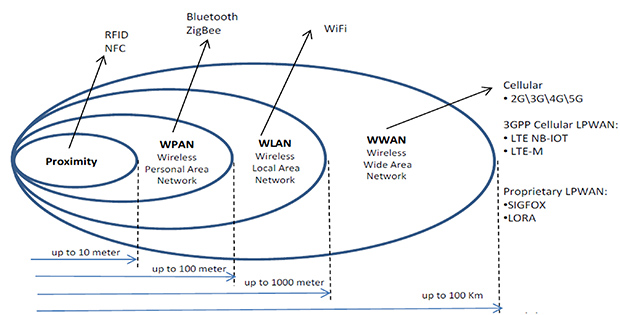Energy optimisation communication methods used in Industrial Applications
When selecting a communication method for IIoT devices in industrial applications, several factors must be considered: maximum throughput, distance range, availability in the deployment zone, and energy consumption. Smart Manufacturing Communication Technologies are discussed in Section 3 of the whitepaper, "Smart Solutions for Energy Efficiency" (click here for more information). This blog discusses the main communication protocols and their impact on energy consumption.
IIoT applications contains groups of sensors that are connected to sensor nodes. The transmission time is determined by the distance between two nodes, the data rate, and the message size, all of which have an impact on energy optimisation. Indeed, the higher the data rate, the less amount of time needed to receive/transmit data, resulting in energy consumption reduction. Sensor nodes are generally battery-powered devices, whose lifetime is influenced by several factors, external from the battery technology, design, and manufacturing quality.
Adoption of a wireless connectivity solution would provide extremely low energy consumption for devices whilst retaining the ability to quickly transmit huge amounts of data over varying distances, with all of this to remain economically viable.
Wireless Communication Technologies used in Industrial Applications:
As illustrated in the image below, the range of a wireless network for industrial applications is commonly classified into three classes: wireless personal area networks (WPANs), wireless local area networks (WLANs), and wireless wide area networks (WWANs).

Fig 1: Wireless Connectivity Technologies
WPANs usually cover a range of about 100m. These devices, such as BLE, ZigBee, NFC, and Thread connection, often have low radio transmission energy and run on small batteries. Most of the time, these devices are in sleep mode. When an event occurs, the device wakes up and sends a short message to a gateway, PC, or smartphone. A typical BLE module has the maximum/peak power consumption of 39mA or less, whilst the average power consumption is around ~9 μA. The active power consumption is a tenth of that of conventional Bluetooth Technology. In low-duty cycle applications, a button cell battery could provide 5-10 years of reliable operation.
WLANs usually cover a range up to 1000m. Wi-Fi is the most common standard. 802.11 ax is one of the newest generations of Wi-Fi standards which is also called Wi-Fi 6. Wi-Fi 6 offers higher data rates and capacity, up to 9.6 Gbps, and operates in both 2.4 GHz and 5 GHz spectrum. Wi-Fi 6 also introduces a new technology that optimises the power requirements at the client end. Target Wake Time (TWT) reduces consumption by allowing the access point and the client to negotiate exactly when the receiver should wake up to hear the sender’s transmission.
WWANs usually cover a range up to 100km. Cellular technology (2G, 3G, and 4G) is used for long-range remote device connectivity. 5G technology that is currently being deployed, promises a massive bandwidth and extremely low latency which could favour its adoption. Cellular connectivity has historically been focused on range and bandwidth at the expense of energy consumption. The high amount of data produced by devices was hard to process quickly and the amount of time between when data is sent from a connected device to when it returns to the same device—the latency—was high. However, new cellular technologies like 5G transmit data about 10 times faster than 4G, promising ultra-low latency and lower power consumption.
Low Power Wide Area Network (LPWAN) technologies are well suited to the specific needs of machine-to-machine communication (M2M) and IoT devices. The technology offers low power, long-range (up to 10–50 km in rural zones and 1–10 km in urban zones). The network works in both licensed (NB-IoT and LTE-M) and unlicensed spectrum (Sigfox and LoRa).
LTE-M is optimised for higher bandwidth and mobile connections. It has a Reduction of 1.4 MHz device bandwidth both on uplink and downlink, Reduced 20 dBm maximum transmit power, Improvement in LTE coverage corresponding to 15 dB for FDD(Frequency Division Duplex), and Enhances the LTE DRX cycle to permit longer inactive periods and consequently optimise battery life. NB-IoT offers lower bandwidth data connections, with a device bandwidth of 200 kHz on both the uplink and downlink. It also provides a 20-dB improvement in LTE coverage.
Both Sigfox and LoRa are asynchronous communication protocols. Sigfox and LoRa end devices are in sleep mode most of the time outside operation, which reduces the amount of consumed energy. Sigfox, LoRa provides class C to handle low-bidirectional latency at the expense of increased energy consumption.
Farnell has partnered with many different suppliers categorising to a wide range of communication technologies products, and solutions portfolios, such as: Network gateways and kits, RFID modules, Networking modules, Bluetooth Modules, ZigBee modules, Sub- GHz, Sensor, Network control-wireless, process control-Wireless, RF / Wireless Development Kits
Stay informed
Keep up to date on the latest information and exclusive offers!
Subscribe now
Thanks for subscribing
Well done! You are now part of an elite group who receive the latest info on products, technologies and applications straight to your inbox.






